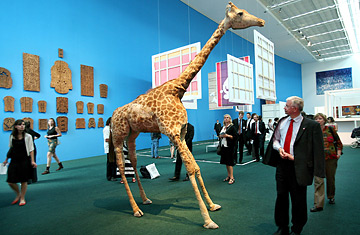
Visitors walk past "The Zoo Story" a work by the artist Peter Friedl at documenta 12 in Kassel, Germany, June 15, 2007.
The dirty little secret about Europe's "Grand Tour of Contemporary Art" this summer is that there simply isn't enough good art to go around. The Grand Tour, of course, is this year's unprecedented coincidence of well-established major art extravaganzas — the Venice Biennale, the bi-annual ArtBasel in Switzerland, the quinquennial Documenta in Kassel, Germany — all of which opened during the same week in mid-June. And they've even added the Sculpture Project at Muenster in Germany, which is only held once every 10 years.
That means Europe's curators have had to hang and install more than 1,400 works by some 400 artists. Clearly, it can't all be of prime quality. In fact, sometimes, they've had to scrape the bottom of the barrel.
"Everybody knows there's just not enough good art to meet this kind of demand," says Maria Finders, a London-based art event organizer. "But the positive side of that is that it's giving younger artists a chance to emerge."
It's not hard to tell where the mega-shows are coming up short. At Venice (which carries on til Nov. 21), the large, haunting installations Felix Gonzales Torres produced for the United States Pavillon are widely admired. So are the oversized photo theatricals of German artist Thomas Demand, like "Embassy," which reproduces the Niger Embassy room in Rome where the now infamous forged Iraqi "yellowcake uranium" document was purloined. But a 3-D video "Last Riot," by the Russian artist team AES+F, purporting to show the cutthroat chaos of our cybernetic video-game-like future, is more creepy than apolcalyptic. And a series of wiseacre sketches and a neon installation by British bad-girl artist Tracey Emin — who shot to fame in 1999 when she installed her own unmade bed in the Tate Modern — have been panned as banal. Similarly, if there were enough good new art, a deeply affecting picture of a child warrior in fatigues by Congolese artist Cheri Samba, might find itself flanked by more where that came from, instead of familiar abstracts by established artists Ellsworth Kelly and Gerhard Richter.
Obviously, the fairs have a powerful impact on the hot — some say overheated — modern and contemporary art market. At ArtBasel, which unlike the "curated" Biennale and Dokumenta is an openly commercial fair, the Marlborough Gallery sold a Francis Bacon, "Orange Male Nude before Mirror," for $20 million. Jeff Wall light-boxes went for $672,000. And it became clear that "signature-value" rather than any original quality was at play when Roy Lichtenstein silk-screens — in an edition of 50 — drew $47,000 each. At those prices, younger artists were certainly bound to benefit. A leading Berlin gallery, Eigen+Art, which discovered the Leipzig School, sold a large work by young German sculptress Stella Hamberg for $114,000, while another by young Italian sculptor Arcangelo Sassolino was sold by Gallery von Senger for $45,000.
Dokumenta exhibited some dazzling showpieces. Visitors stopped in their tracks at the sight of Brazilian artist Iole de Freitas's untitled 30-meter length of curving steel and silver plexiglas that glides over itself like a highway to heaven. They marveled, too, at famous Chinese artist Ai Weiwei's "Template", an 8-meter-high installation composed of interlocked wooden doors and windows from the Ming and Qing dynasties. And they strived to fathom meaning from big, darkly symbolic canvases by German painter Monika Baer, the Chilean-Australian Juan Davila and African-American Kelly James Marshall. But they also noted that a number of them were not new at all, but dated back even to the '50s and '60s. Where was the rest of the new, truly contemporary material?
Clearly, if there had been enough strong art to go around, viewers wouldn't have had to doze off in front of politically correct, excruciatingly prolonged videos such as one about Barcelona prostitution, a child rolling around on an Iraqi prayer rug, or "This Is how We Walk on the Moon." That one should more aptly have been titled "My Perfectly Ordinary Home Movie about Sailing in Scotland."
